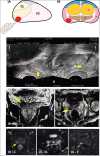Safety and feasibility of freehand transperineal prostate biopsy under local anesthesia: Our initial experience
- PMID: 35136293
- PMCID: PMC8796764
- DOI: 10.4103/iju.iju_222_21
Safety and feasibility of freehand transperineal prostate biopsy under local anesthesia: Our initial experience
Abstract
Introduction: With the emergence of multidrug-resistant organisms causing urosepsis after transrectal biopsy of prostate, the need for an alternative approach has increased. We assessed the safety and feasibility of transrectal ultrasound (TRUS) guided free-hand transperineal prostate biopsy under local anesthesia (LA) for suspected prostate cancer.
Materials and methods: This prospective study was conducted from July 2019 to December 2020 in which patients with elevated prostate-specific antigen (PSA) and/or abnormal digital rectal examination underwent magnetic resonance imaging-TRUS cognitive fusion transperineal prostate biopsy (target and systematic) using coaxial needle. Demographic, perioperative, and outcome data of 50 consecutive patients were analyzed.
Results: The mean age of the patients was 69.6 ± 7.61 years, median PSA 13.55 ng/mL (4.17-672) and prostate size 45cc (16-520). Prostate Imaging-Reporting and Data System (PIRADS) 2, 3, 4, and 5 lesions were found in 2, 12, 12, and 24 patients, respectively. Average procedure duration was 20 min (15-40 min) and number of cores ranged from 12 to 38 (median 20). Forty out of fifty (40/50) patients experienced only mild pain with visual analog scale ≤2. Histopathological examination showed adenocarcinoma, benign prostatic hyperplasia, and chronic prostatitis in 41, 5, and 4 patients respectively with 82% cancer detection rate (CDR). Over 95% of cases showed clinically significant cancer (International Society of Urological Pathology class ≥ 2) and 91.7% of patients with PIRADS score 4/5 and 66.7% with PIRADS score 3 had malignancy. Three patients developed complications (two hematuria, one urinary retention), both were managed conservatively and none had urosepsis.
Conclusions: Free-hand transperineal prostate biopsy by coaxial needle technique under LA is safe and feasible with good tolerability, high CDR, and minimal complications particularly reduced urosepsis.
Copyright: © 2022 Indian Journal of Urology.
Conflict of interest statement
There are no conflicts of interest.Conflicts of interest: There are no conflicts of interest.
Figures





Comment in
-
Re: Sivaraman A, Ramasamy V, Aarthy P, Sankar V, Sivaraman PB. Safety and feasibility of freehand transperineal prostate biopsy under local anesthesia: Our initial experience. Indian J Urol 2022;38:34-41.Indian J Urol. 2022 Jul-Sep;38(3):242-243. doi: 10.4103/iju.iju_92_22. Epub 2022 Jul 1. Indian J Urol. 2022. PMID: 35983115 Free PMC article. No abstract available.
References
-
- Ghose A, Khochikar M, Sabnis R, Parmar NM, Purkait I. Expert group consensus opinion on prostate cancer diagnosis and management in India: Part 1 of 2. Korean J Urol Oncol. 2020;18:170–82.
-
- Fütterer JJ, Briganti A, De Visschere P, Emberton M, Giannarini G, Kirkham A, et al. Can clinically significant prostate cancer be detected with multiparametric magnetic resonance imaging? A systematic review of the literature. Eur Urol. 2015;68:1045–53. - PubMed
-
- Stewart CS, Leibovich BC, Weaver AL, Lieber MM. Prostate cancer diagnosis using a saturation needle biopsy technique after previous negative sextant biopsies. J Urol. 2001;166:86–91. - PubMed
-
- Wright JL, Ellis WJ. Improved prostate cancer detection with anterior apical prostate biopsies. Urol Oncol. 2006;24:492–5. - PubMed
-
- Barringer BS. Prostatic carcinoma. J Urol. 1942;47:306–10.
LinkOut - more resources
Full Text Sources
Research Materials
Miscellaneous
